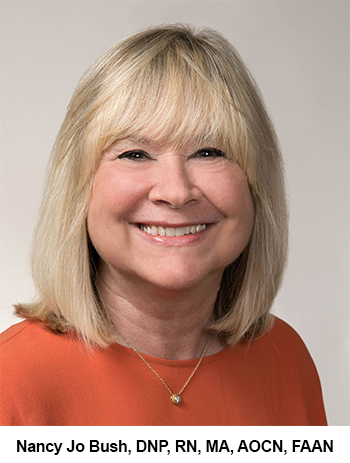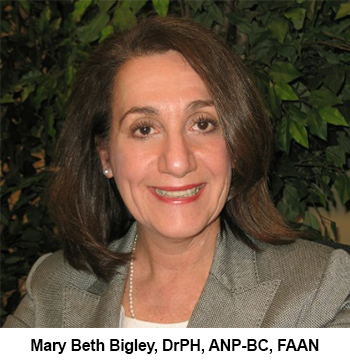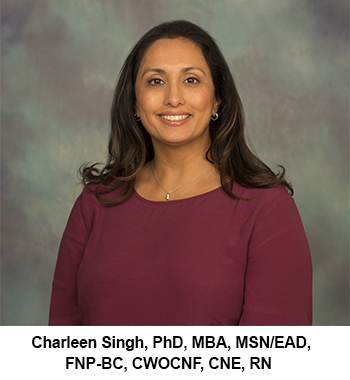By Dorsey Griffith
Contributing Writer
California nurse practitioner programs are increasingly offering the Doctor of Nursing Practice (DNP) degree as the preferred entry-to-practice degree for the profession, following the recommendations of the American Association of Colleges of Nursing (AACN) and the National Organization of Nurse Practitioner Faculties (NONPF).
At the same time, several universities, including the University of California Schools of Nursing, are phasing out their NP master’s degree programs. The move aims to encourage postbaccalaureate nursing students to pursue the DNP.
Not everyone supports the transition. Some worry that DNP program costs and duration will turn off potential applicants – especially those from disadvantaged communities – and exacerbate the nursing shortage.
Why the Switch?
The transition from the master’s entry-to-practice degree to the DNP is rooted in the belief that DNP-prepared NPs are better equipped to serve as health care leaders, taking the profession to a higher level with enhanced competency in health care policy, informatics, and evidence-based practice. Nurse leaders also cite better compensation and career opportunities.
“I believe it will change the face of the profession,” said Nancy Jo Bush, DNP, RN, MA, AOCN, FAAN, Director, Doctor of Nursing Practice Program at UCLA School of Nursing, which launched its post-master DNP in 2018 and will close its master’s advanced practice registered nursing program in 2025 to launch a three-year post-baccalaureate DNP program.
“The DNP degree elevates nursing to be at the table with other doctorate-prepared members of the clinical interprofessional team. It’s very important that nursing be recognized as a profession and not just a job.”
Bush said graduates of the UCLA DNP program have gone on to become assistant directors of advanced practice providers, work in quality improvement and evidence-based practice and are more equipped to contribute to health care advocacy and clinical research.
“More and more DNP graduates are starting to publish their work in scholarly journals,” she said. “Medical and nursing journals are starting to recognize the importance and impact of the DNPs’ clinical projects. One of our graduate students just got her DNP project paper accepted by Nursing Outlook, the journal of the American Academy of Nursing.”
DNP students complete graduate-level coursework that goes way beyond most master’s degrees, noted Tiffany Nielsen, DNP, APRN, FNP-C, ENP-C, DNP, Program Co-Director of Academic Affairs at UC Irvine’s Sue & Bill Gross School of Nursing. 
“It creates nursing leaders in health care, which we desperately need, and it positions NPs to positively change patient care, care delivery and policy. It creates experts in quality improvement and translational science so we can bridge the gap between research and implementation.”
A Decades-old Idea
The push to the DNP is not new, said NONPF CEO Mary Beth Bigley, DrPH, ANP-BC, FAAN.
“There were recommended educational reforms of all health professions from the Institute of Medicine’s triad of reports from the early 2000s,” she said. “Core competencies addressing interdisciplinary education, quality improvement and informatics were areas identified that would be new to the nursing curriculum. Our health care system has become more complex, and we need to change with it. We need our practice to be not only at a micro-level but to also be system-level providers.”
NONPF set an aspirational goal to have all programs transition to the DNP by 2015; today the goal is 2025. According to 2023-2024 AACN enrollment data, of the more than 530 NP education programs nationwide, about half offer postbaccalaureate/BSN to DNP degree NP programs. Of these, approximately 120 NP programs offer the NP DNP degree program without an NP MSN degree program. Additionally, about half of MSN NP degree programs offer a post-masters DNP certificate program, indicating continual growth of the DNP NP programs. 
For the first time, the 2023 report shows a decline of MSN-NP programs with five programs closing. Additionally, data demonstrates a significantly higher certification exam pass rate for DNP-NPs compared with non-DNP-prepared NPs.
Bigley said a key reason for the shift to the DNP for entry to practice is the need to improve the quality of care, particularly to reduce preventable and undesirable clinical outcomes, which according to research from Johns Hopkins University are the third leading cause of death in the United States.
“Errors happen because providers don’t listen to patients and because of poor communication across the health care system,” Bigley said, adding that reducing errors requires evidence-based practice guidelines, interdisciplinary communication, quality management and informatics – all part of a DNP education. “When the credit hours for this modernization of NP curriculum are added to the existing curriculum, the credit count exceeds that of a master’s level degree and aligns with a doctoral degree,” she said.
Charleen Singh, PhD, MBA, MSN/EAD, FNP-BC, CWOCNF, CNE, RN, directs the two-year-old DNP-FNP program at the UC Davis Health Betty Irene Moore School of Nursing. She said they have separated their NP and PA master’s level program and transitioned to a DNP-FNP program so that anyone coming into the school who wants to be an NP will earn a doctorate. The post-baccalaureate DNP-FNP degree program is a three-year hybrid program.
“It's nice to be able to come into a program and not have to go through another graduate school application process,” she said.
"A DNP degree makes you more competitive for positions, especially when it's combined with years of clinical practice," she said. "The earlier in your career that you have a DNP, the more opportunities you may have to participate in clinical research, quality improvement projects, grant writing and funding and teaching.
"Nursing is very holistic," she added. "We don’t just think about that person but all the internal and external factors that affect wellbeing. The degree allows an individual to explore an area they are interested in and look at all the system levels that impact an individual’s health."
The UCSF School of Nursing now only accepts nurses with BSNs into its DNP program and has retained its post-master's degree programs. The DNP pathway is accepting its first cohort of students this summer, according to the school’s website.
Not every school that educates NPs is prepared to end its NP master’s program. At Samuel Merritt University (SMU), the leadership team is monitoring the evolving landscape of APRN MSN education and changes at other universities, according to a joint statement from Catherine Tanner, DNP, FNP-C, Tal Sraboyants, DNP, FNP-C, CHFN and Mary Wykoff, PhD, MSNB, FNP-BC, NNP-BC, CCNS FAANP.
SMU currently offers an FNP program, including a certificate, an MSN for entry-level and post-BSN students, and a DNP. It also offers a DNP-post master’s program for NPs.
Noting that neither the AACN nor the AANP has committed to adopting the DNP as the sole entry-to-practice degree, the SMU leaders said that while they recognize the importance of doctoral-level preparation for NPs to serve as leaders and change agents in health care, “SMU also identifies the ongoing need for advanced nursing degrees aimed at clinical practice. Our goal is to offer inclusive and flexible educational paths to accommodate applicants at various stages of their careers and lives, ensuring they can successfully pursue an FNP designation.”
CANP President-Elect Aimee Paulson, who is a DNP and a DNP instructor, said that while the DNP has opened doors for various activities, including teaching, she worries that making the DNP the sole entry-to-practice degree for NPs will discourage many potential applicants and ultimately exacerbate the nursing shortage.
“If we are trying to promote equity within the profession it needs to be accessible for everyone,” she said.
Remaining Obstacles
Nurse leaders acknowledge that hurdles remain for full adoption of the DNP as the sole entry-to-practice degree. One is getting full buy-in from nurses and nursing organizations.
NONPF’s Bigley said nurse accreditation and certification organizations don’t always agree with the NP-specific academic preparation standards determined through the consensus of 19 NP education stakeholder organizations. She added that academic standards are needed to reduce the variability of graduates and ensure readiness to enter the complex health system as autonomous providers upon graduation. The most common disagreement is about the number of direct patient hours that should be required for sufficient educational preparation.
“Until we have true competency-based education, we will have to rely on hours,” she said. “To get to competency-based education, a recommendation from the IOM reports, we have to build assessment instruments, redesign our program delivery and train our faculty. We are doing the work but it will take some time.”
Bigley added that to build DNP programs you need DNP-prepared faculty, which requires faculty development.
Cost is another consideration, as full DNP programs can cost between $40,000-$70,000.
“The hardest part is to educate prospective students,” said NONPF fellow Marcy Ainslie, EdD, APRN, FNP-BC. “Students are looking for the quickest, cheapest program. How do we educate them about differentiation of degree, assessing program quality, finding HRSA grant-funded scholarships and accessing employer-based tuition reimbursement before they apply?”
At UCLA, another challenge is getting health system leaders to understand the DNP program because other doctoral programs are steeped in research, not the translation of research.
“Even after launching six years ago, we are not understood well,” said Bush. “The campus leadership is not as familiar with nursing or the clinical practice degree, and many non-clinicians are not as familiar with evidence-based practice, quality improvement, policy analysis – things the DNP focuses on.”
For example, she said, the committee that reviews DNP student clinical projects requires includes two PhD faculty members who are unfamiliar with the the clinical focus of a DNP project and often make it more research-oriented.
But Bush is optimistic, both for the growth of the DNP program and its broader acceptance. “I tell my students, ‘This is an investment in your future. It will pay off.’ They will be at the table and be strategic planners with the rest of the team, looking at health care issues in the hospital, implementing quality assurance, and impacting policy. DNP-prepared nurses will go one step further and contribute more to the interdisciplinary team.”